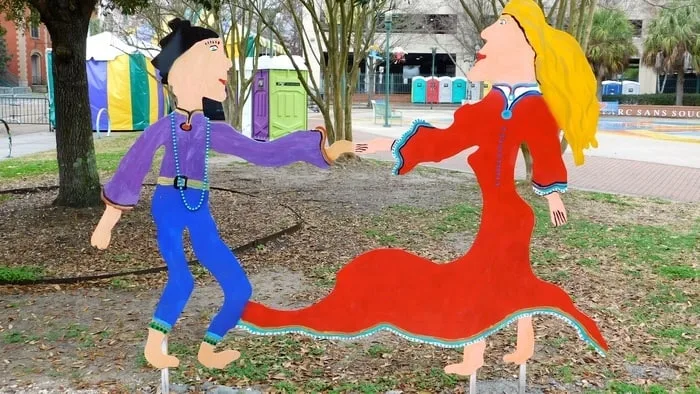Louisiana’s Cajun culture outside of New Orleans. Lafayette, in the center of the Acadiana region, is an accessible and affordable jumping-off point for exploring Louisiana’s unique food, music and history with kids.
Take advantage of Lafayette’s small downtown and use it as a base for day trips around the region. You’ll be happy to come to Lafayette at night for its ample hotel selection and dinner at any of its many great local restaurants.
• Read more:
• Things To Do In San Antonio After You Visit the Alamo
• Do These Bucket List Activities On Your Dallas Getaway
Here are four day trips you can easily do with kids in Lafayette, plus what to expect during Lafayette’s family-friendly Mardi-Gras season.
5 Unique Things To Do With Kids In Lafayette
Walk through local history
Vermilionville is probably the best place to start with school-age kids. This living history museum is ten minutes from downtown Lafayatte. It offers the hands-on history kids like, and you can explore it at your own pace.
The site brings together a collection of houses that show how different social classes lived in the area in the 17th, 18th, and 19th centuries. There are also functional buildings, including a metal forge, school house and shoemaker’s workshop. You’ll find costumed interepreters ready to explain the buildings and do demonstrations.
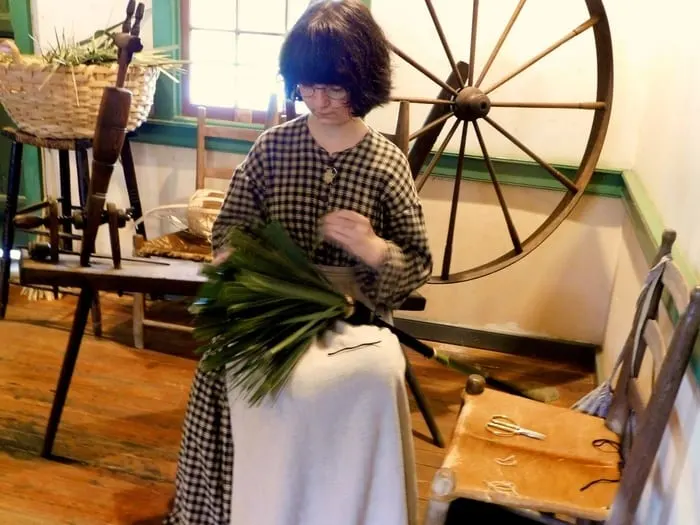
The village explores many aspects of Louisiana history, including the suppression of Cajun’ French in its rural communities. In keeping with these Acadian roots, the interpreters speak French and tours are available in the language too.
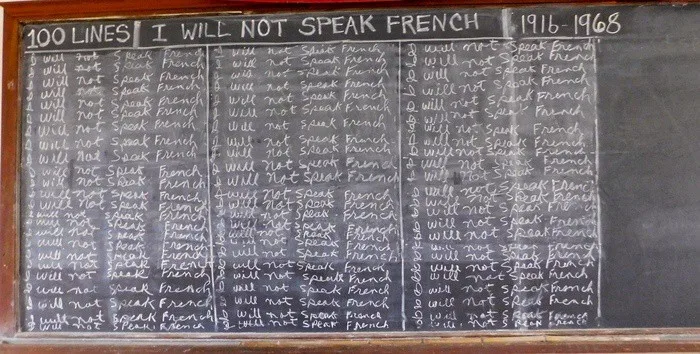
It’s worth checking Vermilionville’s calendar before you visit to see what activities are coming up.
If you visit on Saturday afternoons you’ll find improvised music sessions. On Sunday afternoon there’s usually a fais-do-do with good live music. Watch dancers of all ages hit the dance floor wearing everything from jeans and Ts to their Sunday best.
There are sometimes cooking demonstrations on weekends and special cultural activities for various holidays and cultural days.
There Cuisine de Maman café serves Cajun food, including a weekend buffet where you can sample local boudain, jambalayas, gumbos, red beans and rice and more. On other days there’s an a la care menu.
Explore the museum, have some lunch and then hit the dance floor or hear some live music. It’s a full and perfect day that works easily for kids and adults.
Paddle the Bayou
A bayou is a forest that’s been flooded. On a cold February day, we went canoeing on Lake Martin, in the Bayou Teche, a cypress and tupelo forest that was swamped in the 1950s.
The paddling was easy. Kids older than an 8YO or so could paddle with an adult in their canoe. Kids too small to paddle can sit between two adults.

In the warm weather, paddlers can see birds, turtles, bullfrogs, fish and enormous ‘gators. In February, the alligators were at the bottom of the water hibernating (which I didn’t mind).
We spotted a few birds, but otherwise mostly just saw the bayou’s distinct trees and Spanish moss. But Louisiana’s Bayous set the mood in so many movies and stories that it was cool to actually get a close-up look at one. This is an easy, kid-friendly way to do it.
Taste Tabasco at the Source
Fact: Avery Island is technically an island.
Also fact: It’s in the middle of Louisiana and not off the Gulf Coast, as Tabasco Sauce users assume it is.
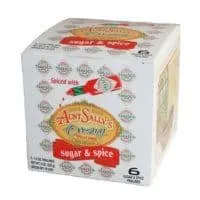
This “island” is a mound of earth surrounded by network of streams and small bayous. It’s still home to the Tabasco factory and its pepper farm. It offers a factory tour, restaurant, shop and museum, along with the exotic Jungle Gardens.
About half of Tabasco’s employees live on the island, as do founder Edmund McIlheney’s descendants, who still run the company.
The Tabasco Tour
The tour is not long and is self-guided, so you can do it at a pace that suits your family and take a break if you need to. If you want to, you can pay extra for occasional specialty tours, not all of which are open to younger kids.
The tour starts in a hot house where tiny, bright Tabasco peppers grow. Then you see where the peppers are mixed with vinegar and locally mined salt and placed into barrels to ferment and age.
The smell of peppers that comes off the sealed barrels is impressive. Eventually, the fermented pepper mixture is poured into large tuns to be finished off, bottled and shipped out.
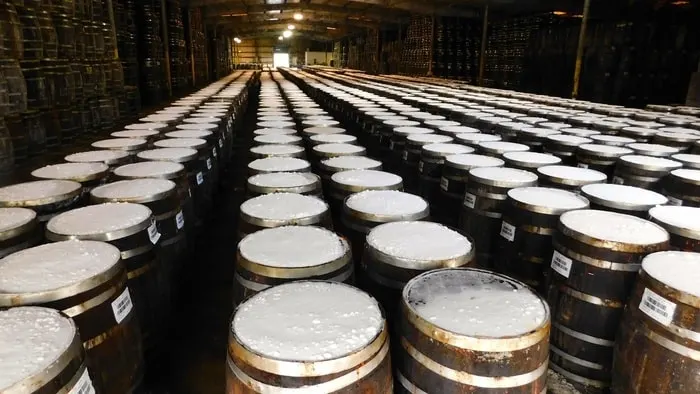
There’s a small museum that will tell you everything you wanted to know about Edmund McIlheney, his little red peppers and the hot sauce empire that began during post-Civil-War Reconstruction.
The gift shop is fun because you can sample every sauce and pickled vegetable McIlheney’s makes, including a few that are only for sale onsite. You can also buy novelties, like chocolates and praline cookies spiced up with Tabasco.
I didn’t get to eat at Restaurant 1868, but it’s casual, reasonably priced and kid-friendly. They have a bloody Mary bar and the menu is a mix of regional dishes like crayfish etóuffée and kid-friendly basics like chicken fingers. It seems likely their goal is to produce good food to complement their hot sauce, which is on every table, naturally.
The Jungle Gardens
It was raining heavily the day I visited, so I mostly saw the Jungle Gardens through a car window.
McIlheney’s son, an early conservationist, created a bird sanctuary on this property in the 1890s. He gradually brought in exotic plants from all over the world, convered the property to the Jungle Gardens in the 1920s and opened them to the public in 1935.
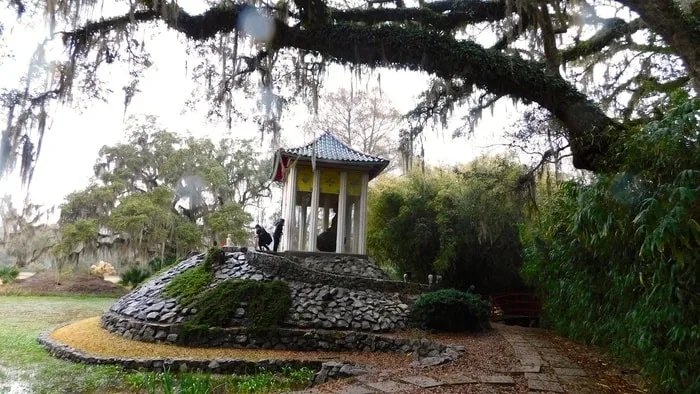
Today you can drive or walk around them, or ideally do a mix of both. There’s still a large bird sanctuary, a pond with an enormous Buddha and lots of small ponds and trees that are home to all sorts of wildlife.
If you visit the Tabasco factory it makes sense to take at least a peak at them. If it’s not raining, it’s a good place to let kids romp a bit before the drive back. Just remember, this is Louisiana. If there’s water, there are alligators.
Sample a Small-Town Mardi Gras
I spent Lundi Gras and the early part of Mardi Gras outside of Eunice in St. Landry Parish, about an hour from Lafayette. I got to experience some unique rural Mardi Gras traditions festivities. It was absolutely the highlight of the trip.
Enjoy a Whole-Pig Cookout
On Fat Monday, I found myself listening to a Zydeco band in a very cold barn in an RV Park. I huddled under a heat lamp with two women from France were teaching locally and a couple who had driven their RV from Washington state. A large sequined disco-chicken hung from the ceiling.
The event was a boucherie, loosely translated as a butchering. We were all waiting to eat.
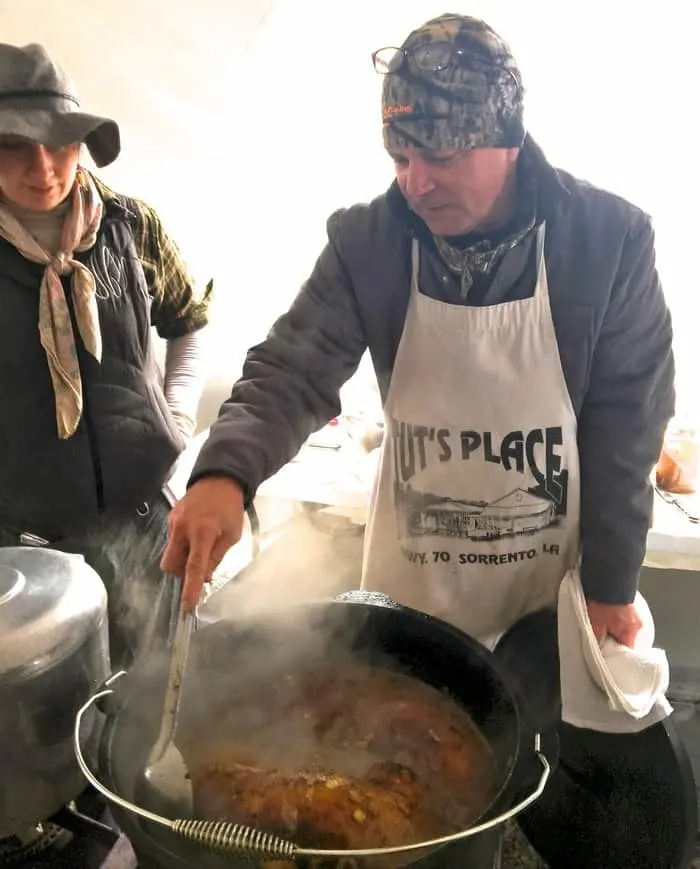
Traditionally it was a feast that rural communities had in the fall to celebrate their bounty and fatten themselves up a bit for winter on the pigs they’d been fattening up all summer.
For this cookout, local volunteers woke up before dawn to kill a pig and divvy up its bits and pieces. Then seasoned amateur cooks spent several hours grilling, stewing, frying and making paté and several kinds of boudin from every part of the pig but the oink.
The folks doing the cooking were happy to explain what they were making, how and why, when their dishes didn’t urgently need them.
I hurried to get in line each time a new dish came out. There were barbecued ham steaks and dry-rubbed ribs and fried cracklings, which are all pretty kid-friendly, but the cracklings went fast.
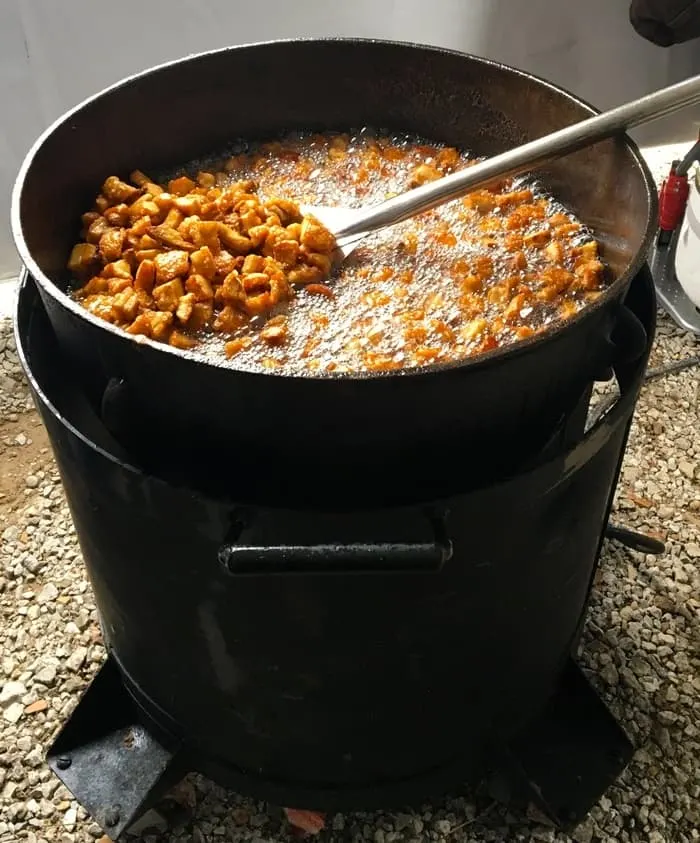
I was determined to try the more exotic stuff, though. Ponce was a round fat sausage that’s cooked in the pig’s stomach in thick brown gravy.
It, and the chewy, sinewy backbone stew both tasted the way things can only after simmering for hours. Both came with rice and white beans seasoned with Tasso ham.
The local boudin is a loose rice-based sausage flavored with bits of meat. Boudin Noir is the same but with the pig’s blood mixed in with the meat and rice. It’s not for everyone, but I love it and they had it.
There was also a paté-like headcheese made with the pigs cheeks and other remnants. I was a little skeptical but it was mild and a great appetizer.
The only thing I skipped was fressures, a stew made from the organs that had a distinct livery smell.
Practical stuff: You don’t have to stay at the RV park; anyone can show up. You buy tickets for the number of dishes you want to try for a few dollars apiece. I recommend buying enough tickets to try everything and sharing.
Doors open at 8:00 AM. People start showing up throughout the morning to hear the music and watch the cooking. Dishes start rolling out around 1:00 and continue into the late afternoon.
Chase a Chicken
I returned to St. Landry’s Parish the next day for the colorful Courir du Mardi Gras, the Fat Tuesday run. The thing they’re running after is a chicken.
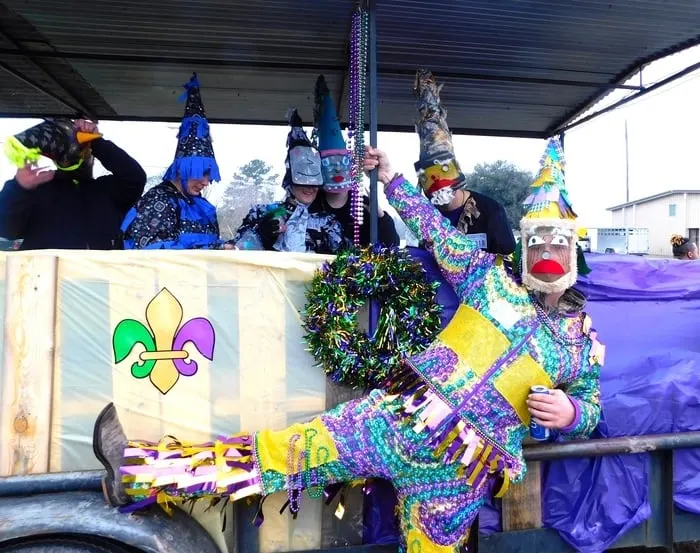
I loved this parade because it showed a community coming together to do something it’s been doing for 100 years. Far more people participate than watch. And they are doing the event for their own enjoyment, not as a show for tourists.
The participants dress up in colorful rag-tag costumes they make, with pointed hats and mesh face masks. They look strange, which is the point. The mask transforms you into someone else, so you can make mischief for a day and then return to your responsible self.
They reminded me of Carnival costumes I’ve seen in the Caribbean.
A century ago, local folks in these beggar costumes went from house to house collecting ingredients for a communal Fat Tuesday Gumbo. If a farmer had a chicken to donate he’d have some fun by letting it go and making the “beggars” chase it.
Now they start cooking the gumbo at the community center in the early morning. But the parade still kicks off with a chicken chase.
They chase six more birds at intervals as a loose collection of floats, horseback riders, musicians and people on foot wind their way around the countryside and into downtown Eunice in the late afternoon.
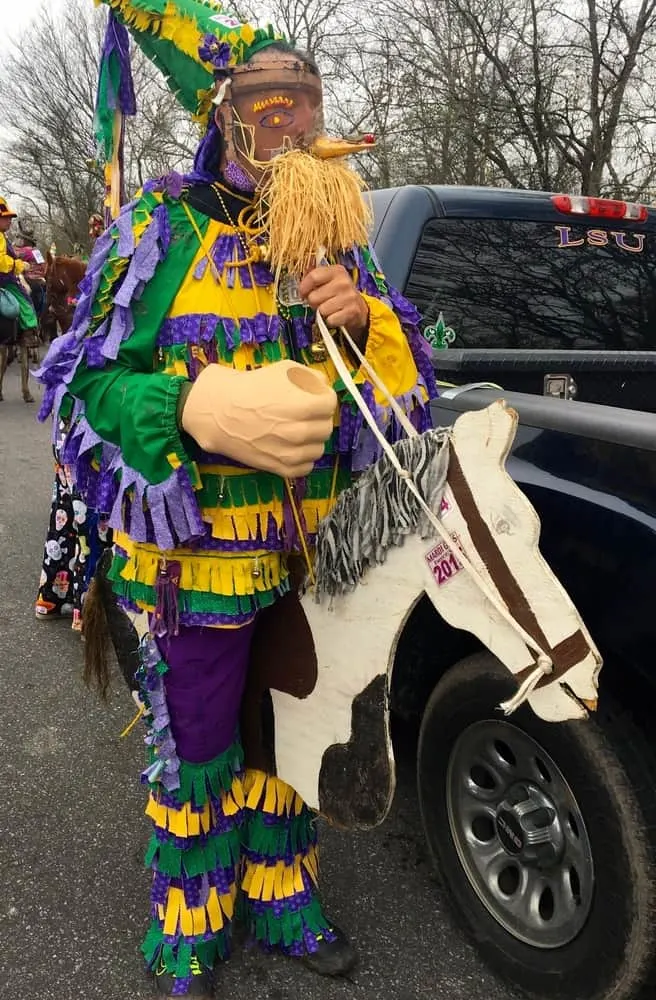
I wouldn’t recommend following the parade the whole day. But it’s worth getting up to the start by 7:30 or so to see the assemblage of costumes, musicians, horses and floats, and to see the chicken chase (the bird gives them a run for their money).
Then you can catch up with the end of the parade in Eunice around 3:00. There’s a small street fair and live music all day. If you’re lucky, you’ll find the gumbo.
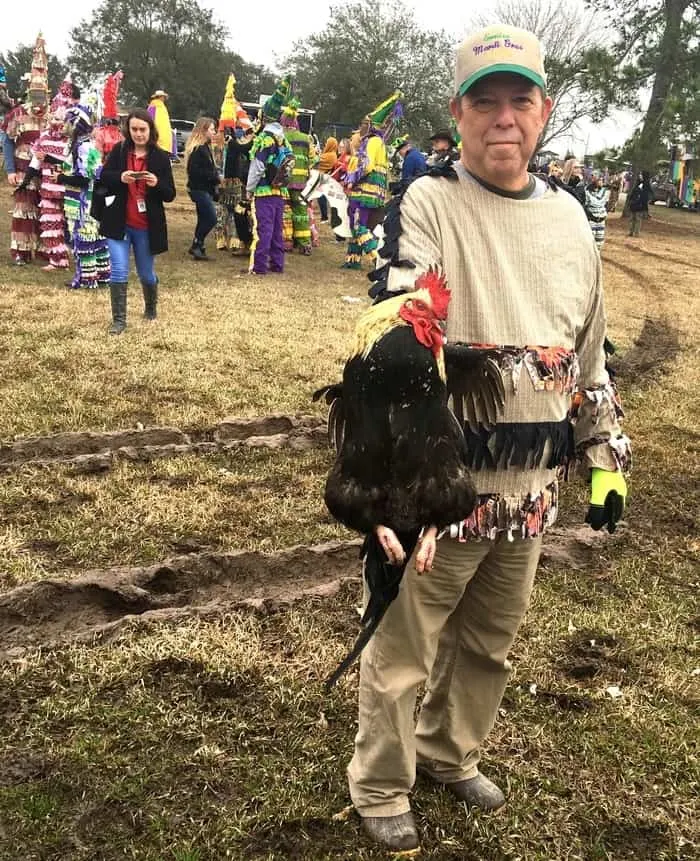
By the way, the chickens are returned to their owners after they’re caught. All you get for catching one is bragging rights.
This is such a local event that I wouldn’t recommend making your way to St. Landry’s just to see it. But it’s so unique and colorful. If you’re in the area, you have to make your way to Eunice to see a bit of it.
Go To A G-Rated Mardi Gras Parade
If you visit the Lafayette area during Mardi-Gras season you have to check out one or two of its more than a dozen parades, organized by different Krewes and civic organizations.
They range from the small communal Krewe de Cannaille parade to the Queen Evangeline’s parade, which features the Mardi Gras queen and her court and has some of the best floats. There’s also a parade just for kids and one for dogs.

Lafayette makes a point of keeping its parades family-friendly. There are kids everywhere. The people on the floats toss beads, plastic cups and small toys and seek out the kids. People on the sidewalk hold signs to attract their attention.
You will see people drinking along the parade route, and surprisingly early in the day. But I didn’t see anyone acting stupid or inappropriate at any of the three parades I went
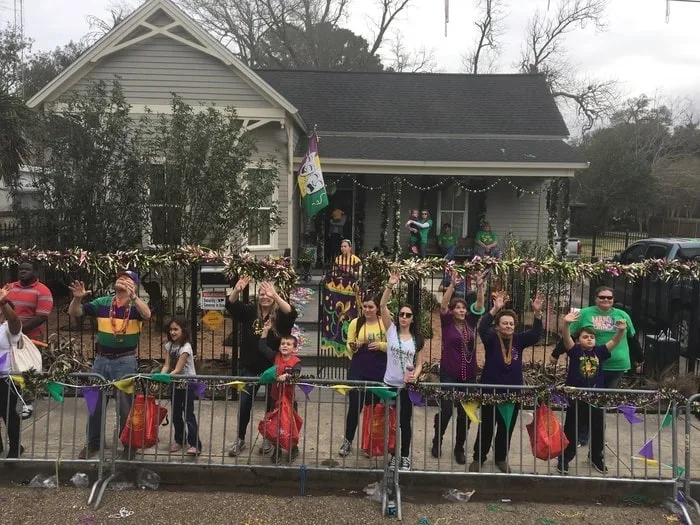
The main parade on Tuesday ends at Cajun Field on West Congress Street, where there’s music, a midway, carnival rides and plenty more food.
Lafayette Hotels Worth Checking In To
The Lafayette area has plenty of hotels to choose from in all price ranges.
The Juliet Hotel is right downtown, a few blocks from Parc Sans Souci, the Science and Children’s museums, the concert stage and several good restaurants.
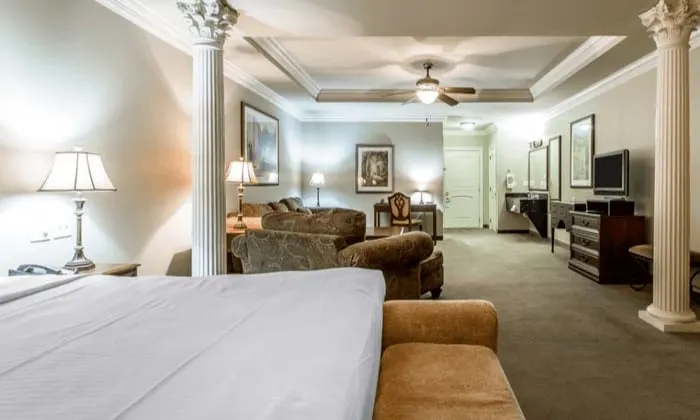
It’s a small boutique hotel, but the rooms include suites and breakfast is included with the room rate. It has a small outdoor pool and hot tub, as well as a sauna and steam room. It’s the hotel to choose if convenience is your priority.
The Carriage House Hotel is an all-suites property located away from downtown in the pedestrian-friendly River Ranch neighborhood. Its two-room suites have microwaves and work well for families. It has a nice walk-in outdoor pool, tennis courts and a spa. There are a few places to eat nearby and a restaurant onsite for breakfast.
It’s the better option if you want more room and like to spend time relaxing at your hotel.
There are plenty of chain hotels around Lafayette at all price points. I stayed at the Doubletree by Hilton, which has good size-standard rooms and a nice riverside outdoor pool for warmer months. It has two restaurants and a bar, where breakfast is available for an additional charge.
There is a good selection of attractive vacation rentals right downtown, too.
St. Landry: If you want to stay in St. Landry overnight, you’ll find your choice of affordable hotel chains in St. Landry and in Eunice.
Pin it for later!
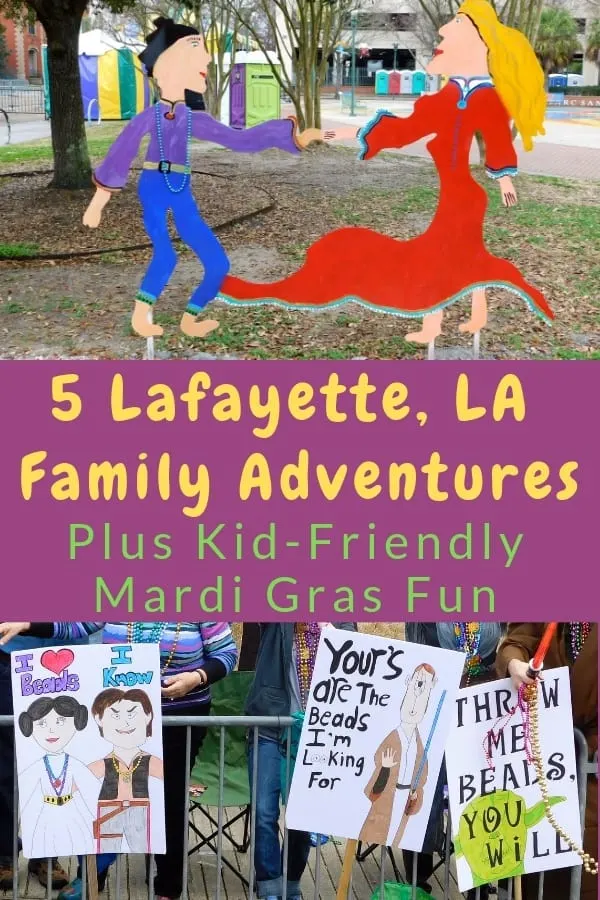
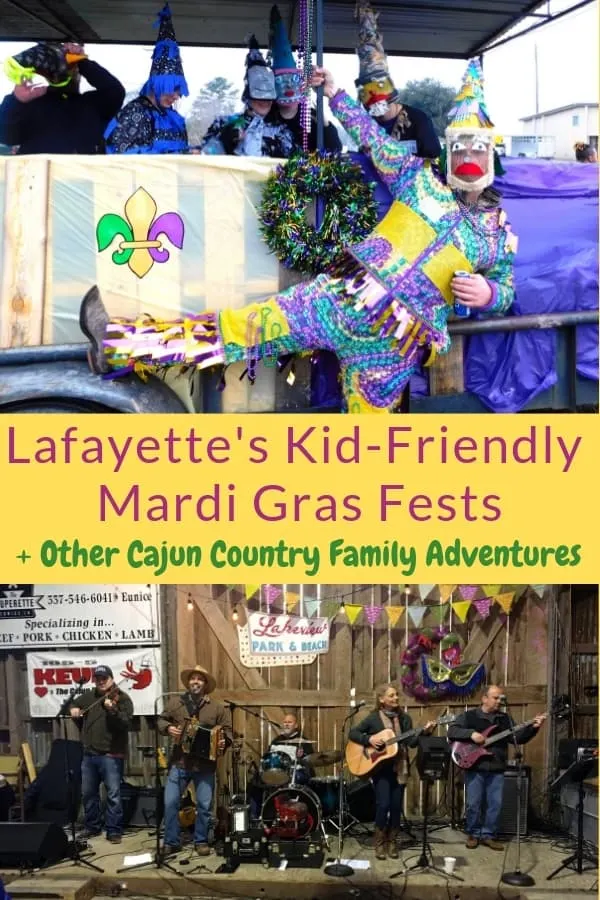
Photos by Eileen Gunn©

